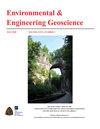美国雷尼尔山国家公园冰川前泥石流预报与地震探测
IF 1
4区 工程技术
Q4 ENGINEERING, ENVIRONMENTAL
引用次数: 3
摘要
位于美国华盛顿州西南部的雷尼尔山冰川火山有着丰富的爆发洪水和泥石流的历史,这些洪水和泥石流在20世纪和21世纪对雷尼尔山国家公园的基础设施造成了不利影响。退缩的冰川留下了大量未固结的土地,在秋季的高降水强度风暴和温暖的夏季爆发洪水期间,这些土地很容易被动员起来。1926年至2019年期间,雷尼尔山记录了60多次泥石流和爆发洪水。泥石流活动导致露营地和游客目的地关闭,这限制了游客进入公园的大片区域。本文记录了泥石流特征和地震监测、绘制灾害地图以及开发干湿天气泥石流预报方法的工作。利用过去泥石流日的当日和历史前天气条件,我们开发了一个泥石流灾害模型,以帮助根据当时和预测的天气条件预测整个公园泥石流活动相对危险度较高的日子。使用美国地质调查局实时地震振幅测量(RSAM)工具近实时地检测泥石流。如果检测到事件,我们可以向em提供疏散警报*通讯作者电子邮件:scott_beason@nps.gov在下游地区工作和娱乐的员工和游客。我们的目标是提前7天准确预测泥石流灾害,然后使用RSAM在泥石流发生后几分钟内检测到泥石流。本文章由计算机程序翻译,如有差异,请以英文原文为准。
Forecasting and Seismic Detection of Proglacial Debris Flows at Mount Rainier National Park, Washington, USA
The glaciated Mount Rainier volcano in southwestern Washington State (United States) has a rich history of outburst floods and debris flows that have adversely impacted infrastructure at Mount Rainier National Park in the 20th and 21st centuries. Retreating glaciers leave behind vast amounts of unconsolidated till that is easily mobilized during high-precipitation-intensity storms in the fall months, and during outburst floods during warm summer months. Over 60 debris flows and outburst floods have been documented between 1926 and 2019 at Mount Rainier. Debris-flow activity has led to the closure of campgrounds and visitor destinations, which has limited visitor access to large swaths of the park. This paper documents efforts to characterize and seismically monitor debris flows, map hazards, and develop forecasting approaches for wet and dry weather debris flows. Using the day-of and historic antecedent weather conditions on past debris-flow days, we developed a debris-flow hazard model to help predict those days with a higher relative hazard for debris-flow activity park-wide based on prevailing and forecasted weather conditions. Debris flows are detected in near-real-time using the U.S. Geological Survey Real-time Seismic Amplitude Measurement (RSAM) tool. If an event is detected, we can then provide evacuation alerts to em*Corresponding author email: scott_beason@nps.gov ployees and visitors working and recreating in the areas downstream. Our goal is to accurately forecast the debris-flow hazards up to 7 days ahead of time and then use RSAM to detect debris flows within minutes of their genesis.
求助全文
通过发布文献求助,成功后即可免费获取论文全文。
去求助
来源期刊

Environmental & Engineering Geoscience
地学-地球科学综合
CiteScore
2.10
自引率
0.00%
发文量
25
审稿时长
>12 weeks
期刊介绍:
The Environmental & Engineering Geoscience Journal publishes peer-reviewed manuscripts that address issues relating to the interaction of people with hydrologic and geologic systems. Theoretical and applied contributions are appropriate, and the primary criteria for acceptance are scientific and technical merit.
 求助内容:
求助内容: 应助结果提醒方式:
应助结果提醒方式:


